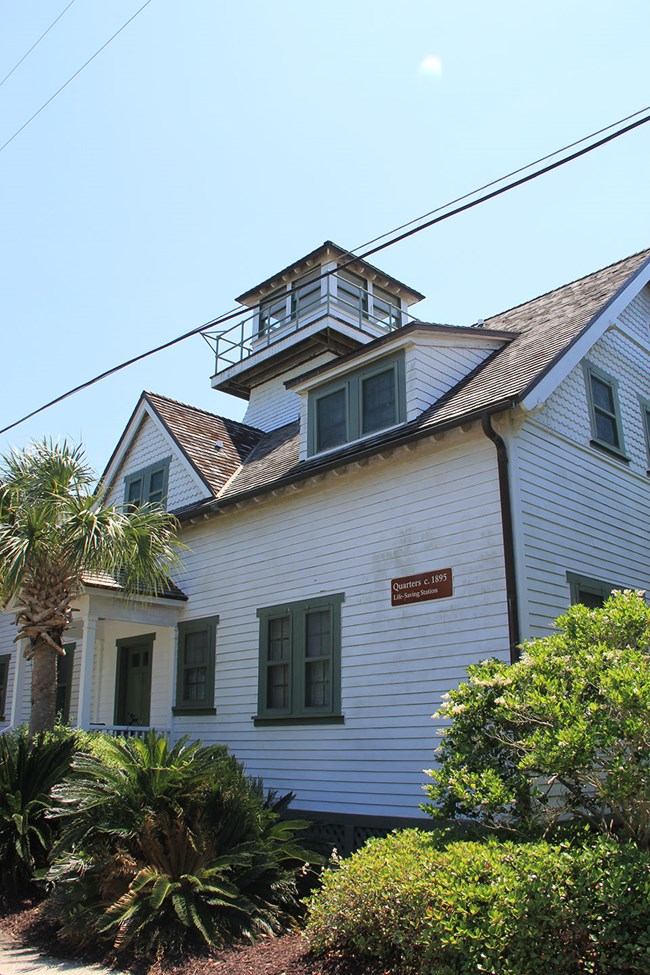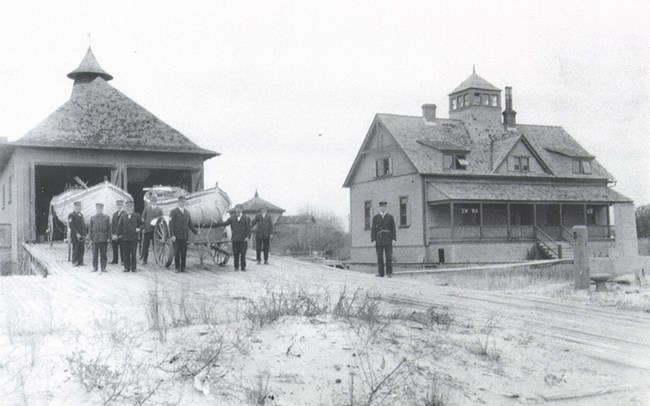
NPS The Storm WarriorsToday it is has become second nature for sailors in distress to call on the Coast Guard. However, help at sea was not historically readily available. The United States Life Saving Service, USLSS, was conceived out of a dire need for a lifesaving network. Until 1878, the only source for those in trouble at sea were lighthouse keepers, volunteers, and private vessels that happened to be nearby. Many miles of the coastline were sparsely populated, so there was little to no help in large stretches of the nation’s coast. In the day of wooden sail ships, many lives were lost at sea just a few hundred yards from shore. In 1871, Sumner Increase Kimball, the chief of the Revenue Marine Service, ordered an inspection of the lifesaving network. Recognizing the great need, he worked to gain $200,000 to employ crews of surfmen. Kimball was chosen as the General Superintendent of the USLSS and remained in that position until the merger of the USLSS and the US Revenue Cutter Service created the US Coast Guard in 1915. Tool Box of the USLSSThe majority of the work-week was spent drilling with the rescue equipment, patrolling, standing duty, and maintaining the station. To perform the duties of the job effectively, good equipment was necessary. The essential craft for the surfmen of a life-saving station was the surfboat. Surfboats were 700 to 1000 pounds, self-bailing (water taken on board will drain without pumping), and self-righting (designed to right itself when capsized). A crew of six men could operate the boat with twelve- to eighteen-foot oars. These surfboats were only used when the surf was not running too high. If the sea was too rough for the surfboats, a strong hawser (line) could be used to reach the stranded victims. An instrument best described as a small mortar, called a Lyle Gun, would propel the line to the distressed mariners. Once the hawser was secured, a life car, a small primeval submarine, was pulled back and forth from wreck to shore. Since the life car was heavy and difficult to handle, it was widely replaced with the lighter, more easy to handle breeches buoy. It was shaped like a lifesaving ring with a pair of fabric shaped shorts sewn on. To access shipwrecks away from the lifesaving station, surfmen used a beach apparatus cart. The cart carried all the needed equipment to the wreck site first by the use of manpower, then horses, and later tractors. The surfmen wore cork life vests, a personal flotation device, for their safety. 
Sullivan’s Island Life-Saving StationThe original lifesaving station in Charleston Harbor was on Morris Island, but the diversion of the main shipping channel made the station too remote to offer swift assistance to sailors traveling through the new channel. It was then decided that the station would be moved to Sullivan’s Island. In 1891, the Township deeded five acres to the federal government for the establishment of the station. The Lifesaving Station on Sullivan’s Island was established in 1894 and completed on August 1, 1895. There was a boathouse that held two 20-foot surfboats that were pulled on a cart by the surfmen to the site of the wreck and then launched directly into the surf. The two-story quarters adjacent to the boathouse housed the crew, which included six men and the keeper. The first keeper was Captain John Adams. Despite the original plan to establish Life-Saving Stations every three miles along the coast to allow for overlapping patrols and mutual aid, this proved to be the only lifesaving station built in South Carolina. Two Sullivan’s Island surfmen died in the line of duty: one in 1898 while performing a rescue and another while on patrol in 1903. James J. Coste, a young newlywed, risked and ultimately gave his life to rescue another. According to a report by The Evening Post, on August 19, 1898, twelve-year old Ned Schachte “grew venturesome and went out far beyond where the surf broke to find himself in water over his head and being carried out to sea.” James Coste braved the rough waters at the entrance of the harbor off of Station 12 on Sullivan’s Island. Others followed behind him and pulled Schachte to safety, but Coste drowned. James Coste posthumously received the Silver Lifesaving medal on April 27, 2013. It was presented to his family in a ceremony on the grounds of the historic Coast Guard District. Among the family present that day was Hal Coste, a Coast Guardsman, who also received the Silver Lifesaving medal for saving the lives of five people off Station 12 in 1991. Michael T. McGuire lost his life in the line of duty on September 4, 1903 while on patrol. The United States Coast GuardAdvances in technology outpaced the usefulness of the Life Saving Service. The advent of steam-powered ships with improved navigational aids made ships less likely to crash near shore. The Service also noted a rise in the number of recreational gasoline-powered boats. Cases involving these boats increased by 58% in the beginning of the twentieth century. Furthermore, there was no retirement system and no compensation for injured crewmen. The Service wasn’t attracting new men, and there were cases of keepers staying in the Service well into their 70s. Superintendent Kimball realized that a merger would be in the best interest of the Service as well as the nation. On January 28, 1915, the US Coast Guard was formed with the merger of the US Life Saving Service and the US Revenue Cutter Service. The US Coast Guard continued the mission and practices of the USLSS. The station on Sullivan’s Island grew to 15 men. In 1919, a sighting station was installed on the property, marking its adaptation for use by the Fort Moultrie Military Reservation. The 1930s saw major renovations to the quarters building and the construction of a four-bay building to house small powered rescue boats, later adapted to serve as a garage for general vehicles. A Signal Tower for flying hazard flags visible to offshore vessels was constructed in 1938. In 1973, five structures on the property were listed on the National Register as the US Coast Guard Historic District. This same year, there was a dramatic decline in Coast Guard activity at the station with the opening of the current Coast Guard Station in downtown Charleston. Following Hurricane Hugo in 1989, most of the property was transferred to the National Park Service. |
Last updated: August 23, 2018
